
The Vauxhall Viva is a small family car that was produced by Vauxhall in a succession of three versions between 1963 and 1979. These were designated the HA, HB and HC series.

The Peugeot 504 is a mid-size, front-engine, rear-wheel-drive automobile manufactured and marketed by Peugeot from 1968 to 1983 over a single generation, primarily in four-door sedan and wagon configurations – but also as twin two-door coupé and cabriolet configurations as well as pickup truck variants.

The Renault Clio is a supermini (B-segment) car, produced by French automobile manufacturer Renault. It was launched in 1990, and entered its fifth generation in 2019. The Clio has had substantial critical and commercial success, being consistently one of Europe's top-selling cars since its launch, and it is largely credited with restoring Renault's reputation and stature after a difficult second half of the 1980s. The Clio is one of only two cars, the other being the Volkswagen Golf, to have been voted European Car of the Year twice, in 1991 and 2006.
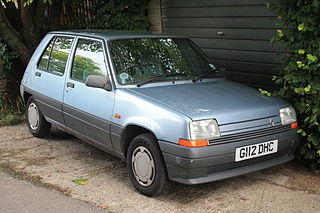
The Renault 5 is a five-passenger, three or five-door, front-engine, front-wheel drive hatchback supermini manufactured and marketed by the French automaker Renault over two generations: 1972–1985 and 1984–1996. The R5 was marketed in the US and Canada as Le Car, from 1976 until 1983. Renault marketed a four-door sedan variant, the Renault 7, manufactured from 1974 until 1984 in Spain by Renault's subsidiary FASA-Renault and exported to select markets.

The Ford Corcel is a family car which was sold by Ford do Brasil in Brazil, Chile, Uruguay, Paraguay and Venezuela. It was also assembled in Venezuela. The French-influenced styling of the Corcel was unique to Brazil until late 1977. From this year, the redesigned Corcel II bore a strong resemblance to the European Ford Escort and Ford Cortina of same era, but its Renault underpinnings remained the same. The Corcel was eventually replaced by the Del Rey, which was originally introduced as a better equipped version of the Corcel.
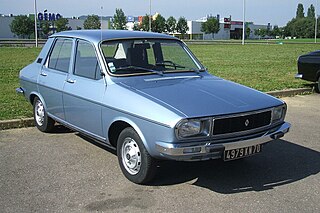
The Renault 12 is a mid-size family car introduced by French automaker Renault at the Paris Motor Show in October 1969 and produced in France until 1980. Available as a saloon (Berline) and estate (Break), it was also produced under licence in many countries around the globe into the early 21st century.
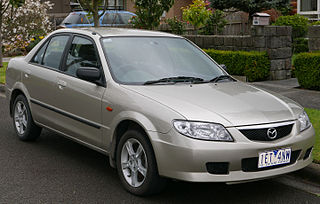
The Mazda Familia, also marketed prominently as the Mazda 323, Mazda Protegé and Mazda Allegro, is a small family car that was manufactured by Mazda between 1963 and 2003. The Familia line was replaced by the Mazda3/Axela for 2004.
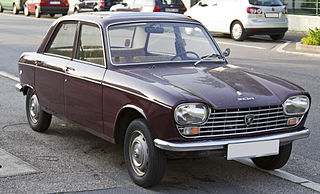
The Peugeot 204 is a small family car produced by the French manufacturer Peugeot between 1965 and 1976.

The Billancourt engine was an automotive engine designed by Renault for the Renault 4CV, used subsequently until 1985. It later received the internal code "B", for Billancourt. The "sport" version is called Ventoux engine.
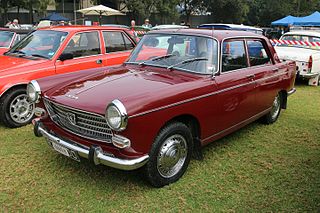
The Peugeot 404 is a large family car produced by French automobile manufacturer Peugeot from 1960 to 1975. A truck body style variant was marketed until 1988. Styled by Pininfarina, the 404 was offered initially as a saloon, estate, and pickup. A convertible was added in 1962, and a coupé in 1963. The 404 was fitted with a 1.6 litre petrol engine, with either a Solex carburetor or Kugelfischer mechanical fuel injection or a 1.9 litre diesel engine available as options. Introduced at the Paris Motor Show as an option was the inclusion of a 3-speed ZF automatic transmission, similar to the unit already offered on certain BMW models, as an alternative to the standard column-mounted manual unit.

The Renault 16 (R16) is a D-segment family hatchback produced by French automaker Renault between 1965 and 1980 in Le Havre, France. The Renault 16 was the first French winner of the European Car of the Year award.

The Fiat 1100 is a small family car produced from 1953 until 1969 by the Italian manufacturer Fiat. It was an all-new unibody replacement for the Fiat 1100 E, which descended from the pre-war, body-on-frame Fiat 508 C Balilla 1100. The 1100 was changed steadily and gradually until being replaced by the new Fiat 128 in 1969. There were also a series of light commercial versions of the 1100 built, with later models called the Fiat 1100T, which remained in production until 1971. The Fiat 1100 D also found a long life in India, where Premier Automobiles continued to build the car until the end of 2000.

The Simca 1100 are a series of French compact family cars – mainly C-segment hatchbacks, but also a compact wagon and popular delivery vans – built for over 15 years by French car-maker Simca, from 1967 through 1982/1985. There was even a very early 'hot hatchback', and a family cross-over: the Matra Simca Rancho. The hatchbacks were replaced by the Simca-Talbot Horizon.

The Alpine A110 is a sports car produced by French automobile manufacturer Alpine from 1963 to 1977. The car was styled as a "berlinette", which in the post-WWII era refers to a small enclosed two-door berline, better-known as a coupé. The Alpine A110 succeeded the earlier A108. The car was powered by a succession of Renault engines. A car also named Alpine A110 was introduced in 2017.
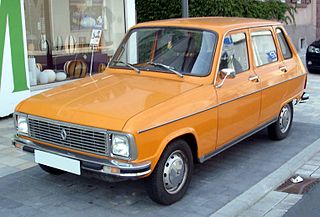
The Renault 6 or R6 is an economy C-segment small family car, manufactured and marketed by French automaker Renault from 1968 to 1986. The R6 entirely used the Renault 4's platform, initially including its small 845 cc (51.6 cu in) engine, and was technically near-identical, but its five-door hatchback body was larger and more modern. Visually it resembled the larger Renault 16, but distincly boxier.
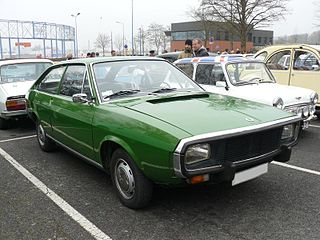
The Renault 15 and Renault 17 are two variations of the same coupé designed and built by French automaker Renault between July 1971 and August 1979. The R17 was sold as R177 in Italy, respecting the heptadecaphobia superstition.

Renault Dauphine is an economy car manufactured by Renault from 1956 to 1967. Like its predecessor, the Renault 4CV, the Dauphine is a rear-engine, rear-wheel-drive four-door sedan with three-box styling. More than two million Dauphines were built and the design was produced under licence by other manufacturers outside of France. Along with such cars as the Citroën 2CV, Volkswagen Beetle, Morris Minor, Mini and Fiat 600, the Dauphine pioneered the modern European economy car. Renault marketed numerous variants of the Dauphine, including a luxury version, the Renault Ondine, a decontented version as the Dauphine Teimoso, sporting versions marketed as the Dauphine Gordini and the Ondine Gordini, the 1093 factory racing model, and the Caravelle/Floride, a Dauphine-based two-door coupé and two-door convertible.

The Renault Caravelle is a sports car manufactured and marketed by Renault for model years 1958–1968 in a single generation — as a rear-engine, rear-drive open two/four-seater designed by Pietro Frua of Carrozzeria Ghia, using the floorpan and engine of the Renault Dauphine.

The Cléon-Fonte engine is a family of inline four-cylinder automobile engines developed and manufactured by Renault. It has also been called the Sierra engine, the C-engine, or the C-Type. It has been in continuous production by Renault or a licensee from 1962 to 2004. After about three decades of use in Renault's compact models, it was gradually replaced by the E-type engine from the late 1980s onward.

The Renault 8 is a rear-engined, rear-wheel drive small family car produced by the French manufacturer Renault in the 1960s and early 1970s. It also formed the basis for the larger Renault 10, introduced in 1965.






















